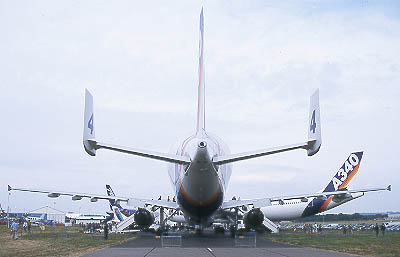 Deja vu Deja vuFarnborough International, 24 - 30 July. Gary Parsons reports.
It was as though time had stood still - the twenty-two
months since Farnborough '98 a mere blink of the eye. The flying display read just as it
did then - C17, Typhoon DA1, Gripen, Airbus A340, Saab 340, F18 Hornet. True, the Hornet
had morphed from a 'D model to the new 'F, bigger and beefier than before, but overall it
was evident that the more things change, the more they stay the same.
Super-duper Hornet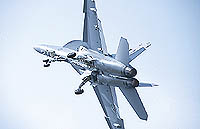 The F/A-18E/F Super Hornet is a next
generation strike fighter, built by the industry team of Boeing, Northrop Grumman, GE
Aircraft Engines, Raytheon and 2,000 other suppliers.
Two versions of the Super Hornet are currently in
production for the U.S. Navy-the single-seat E model and the two-seat F model. Both will
perform a spectrum of missions including air superiority, day/night strike with
precision-guided weapons, fighter escort, close air support, suppression of enemy air
defense, reconnaissance, forward air control and tanker. Converting from one mission to
another is quick and simple - just flick a switch.
With a total of 11 weapon stations, the Super Hornet
provides increased payload flexibility by mixing and matching air-to-air and air-to-ground
ordnance. A typical load for a self-escort mission might start with an advanced infrared
targeting pod, one AIM-120 AMRAAM and two AIM-9 Sidewinder missiles, and an external fuel
tank. This leaves all six underwing weapon stations available to carry a variety of
weapons and other payloads. The F/A-18E/F also carries the complete complement of
"smart" weapons including laser-guided bombs.
Throughout its seven-year development program, the Super
Hornet has been on time, on weight, and on cost. Improved aerodynamic design gives the
F/A-18E/F exceptional combat manoeuvrability, an unlimited angle of attack and increased
resistance to spins and departures.
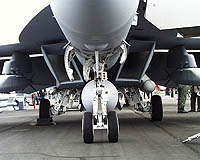
Two General Electric F414-GE-400 engines power the Super
Hornet. The F414 produces a combined 44,000 pounds of thrust. Its nine-to-one
thrust-to-weight ratio is one of the highest of any modern fighter engine. Increased
airflow to the engine is provided through the Super Hornet's distinctive caret inlets.
The first production model Super Hornet was delivered to
the U.S. Navy in December 1998, more than a month ahead of schedule. After completing the
most thorough operational evaluation in naval history, the F/A-18E/F Super Hornet entered
operational service in November 1999.
As of 31 May more than 20 production models had been
delivered to the US Navy. It plans to buy a minimum of 548 Super Hornets through 2010. |
Farnborough is a very different experience to the normal
airshow, especially on the trade days. Driven by big business, corporate hospitality is
the name of the game to be in with the 'in' crowd. What was more apparent this year is the
place the British aircraft industry has within the aviation world, that of component
supplier and partner in some joint venture or collaboration; the lack of aircraft and
expansion of the vast trade halls illustrating the point quite clearly. Many major
international manufacturers could only be found within the cavernous exhibition - key
names such as Mikoyan not bringing any aeroplanes to share with the crowds. Dassault
declined to bring any military aircraft, not even Rafale. Indeed, the participation of
Airbus and BAE Systems was only confirmed at the last minute, a worrying level of
commitment to what used to be the major showcase for new aircraft in the UK.
Airbus announcement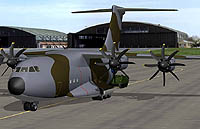 Defence Secretary, Geoffrey Hoon, joined with Ministerial and
other colleagues from six other European nations in a joint declaration to buy a total of
225 European A400M military transport
aircraft, being developed by Airbus Military. He said "Following my announcement,
in May, of the UK's intention to buy 25 A400M aircraft, the commitment of our partners
today allows the launch of this programme and underlines our shared commitment to
enhancing European defence capability. It is a major opportunity for our industries. There
are tough commercial negotiations ahead with industry, not least on price. But we hope to
conclude these satisfactorily so as to be able to award a contract to Airbus Military
early next year."
The nations intend to procure, in an initial order,
aircraft in the following numbers which will be sufficient to launch the programme;
Belgium 7 aircraft, France 50 aircraft, Germany 73 aircraft, Italy 16 aircraft, Luxembourg
1 aircraft in close co-operation with Belgium, Spain 27 aircraft, Turkey 26 aircraft and
the United Kingdom 25 aircraft.
Seeking to develop their joint capabilities in the field
of military air transport and to thereby increase significantly their contribution to NATO
and European defence, the seven nations firmly intend to procure jointly the aircraft in
order to fulfil their requirements for future military air transport capabilities. The
A400M has been specifically tailored to the needs expressed by the nations in their 1996
European Staff Requirement. Therefore, this aircraft will provide the nations with a
flexible capability, covering both the tactical and strategic roles. The joint acquisition
of A400M aircraft offers scope for harmonising operating and support arrangements between
nations and also offers the potential to achieve significant through-life savings. It also
paves the way for greater task sharing in meeting European military air transport demands.
For their part, the nations intend, once the necessary
legal status and arrangements between nations are in place, to invite OCCAR (Organisation
for Joint Armaments Co-operation) to manage the programme through a single contract for
development, production and initial support.
For several nations an early In Service Date is
essential. The nations, subject to the satisfactory negotiation of acceptable commercial
terms and conditions and to the signature of an agreement between the nations, expect a
contract to be awarded to Airbus Military Company at the earliest possible date in 2001. |
Such is the lengthy development timescale of new aircraft
today was one reason why little new could be seen - Eurofighter Typhoon has now been
flying for six years, yet is still two years away from entering service with the RAF. Back
in the sixties, an eight year life would see a 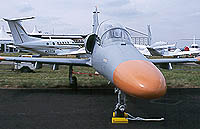 prototype fly, full production and service entry and
scrapping of airframes as they became redundant within seven years or so. This year's hot
topic was the announcement of the Government's commitment to the Airbus A400M, or FLA as
it was known, but again the mock-up has been kicking around since '94, with no sign yet of
a prototype. Ironic too that one of the fighters displayed by the Americans looking for
future sales was the venerable F16, now in its twenty-sixth year of manufacture! prototype fly, full production and service entry and
scrapping of airframes as they became redundant within seven years or so. This year's hot
topic was the announcement of the Government's commitment to the Airbus A400M, or FLA as
it was known, but again the mock-up has been kicking around since '94, with no sign yet of
a prototype. Ironic too that one of the fighters displayed by the Americans looking for
future sales was the venerable F16, now in its twenty-sixth year of manufacture!
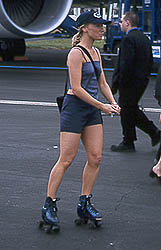 So, although the SBAC's
radio station referred to it as 'the world's greatest airshow', it is anything but. 'The
world's greatest aviation trade fair' may be a better description, and justly so, many
millions of dollars of business being done over the five days. Overshadowed by the crash
of the Air France Concorde early in the week, confidence remained high, led by strong
interest in Boeing's new Longer-Range 777 models. In all, airline customers wrapped up
sales announcements with a cumulative order activity for 139 aeroplanes, totalling $15
billion, but when options and purchase rights are included, total activity rises to 208
aeroplanes valued at $20.7 billion. Included in the week's announcements were 63 Boeing
777 twinjets (plus an additional 17 options/purchase rights), which dominated the
medium-sized jet transport category. So, although the SBAC's
radio station referred to it as 'the world's greatest airshow', it is anything but. 'The
world's greatest aviation trade fair' may be a better description, and justly so, many
millions of dollars of business being done over the five days. Overshadowed by the crash
of the Air France Concorde early in the week, confidence remained high, led by strong
interest in Boeing's new Longer-Range 777 models. In all, airline customers wrapped up
sales announcements with a cumulative order activity for 139 aeroplanes, totalling $15
billion, but when options and purchase rights are included, total activity rises to 208
aeroplanes valued at $20.7 billion. Included in the week's announcements were 63 Boeing
777 twinjets (plus an additional 17 options/purchase rights), which dominated the
medium-sized jet transport category.
Boeing was certainly the manufacturer with the most hardware on
view at FI2000, led by the F/A18E and the C17, plus a full-size mock-up of JSF. On the
civil front, the newest member in the Boeing 767 Family the 767-400ER
(extended range) jetliner - embarked on a month-long world tour on 10 July. Included are
stops at 17 cities in Austria, Germany, Cyprus, The Czech Republic, Poland, China, Japan,
Taiwan, Thailand, Singapore and Korea  as well as the week's stay at Farnborough. The 767-400ER is
sized between the 767-300ER and the 777-200, and features a lengthened fuselage,
aerodynamic improvements, increased takeoff weight, a passenger pleasing 777-style
interior, a new upgraded flight deck and an all-new main landing gear. as well as the week's stay at Farnborough. The 767-400ER is
sized between the 767-300ER and the 777-200, and features a lengthened fuselage,
aerodynamic improvements, increased takeoff weight, a passenger pleasing 777-style
interior, a new upgraded flight deck and an all-new main landing gear.
Also presented by the Secretary of State for Defence was
the announcement in the House of Commons of the government's intention to procure the
Maverick Missile System from Raytheon Company for the Harrier GR7, following the
satisfactory conclusion of trials. Aimed at addressing the main equipment lessons learned
from Kosovo, combat operations confirmed that precision guided 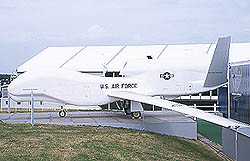 munitions
with low collateral damage are a key requirement in the missions that the RAF now
undertake in support of peace-keeping operations. Maverick is a proven, off-the-shelf
precision guided missile that greatly improves the pilot's capability and flexibility to
attack both mobile and static targets by day and by night. Over 65,000 missiles have been
produced to date with 14,000 launched including 5,300 in Desert Storm and 800 in Allied
Force. During these conflicts, Maverick achieved a 93% success rate. It offers
Lock-on before launch - launch and leave, proven performance against moving armour
vehicles and ships, minimum collateral damage and proven performance against high value
targets. Despite this news, and although BAE was out in force during the week, no Harrier
was to be seen during the trade days, it only displaying on the two public days. munitions
with low collateral damage are a key requirement in the missions that the RAF now
undertake in support of peace-keeping operations. Maverick is a proven, off-the-shelf
precision guided missile that greatly improves the pilot's capability and flexibility to
attack both mobile and static targets by day and by night. Over 65,000 missiles have been
produced to date with 14,000 launched including 5,300 in Desert Storm and 800 in Allied
Force. During these conflicts, Maverick achieved a 93% success rate. It offers
Lock-on before launch - launch and leave, proven performance against moving armour
vehicles and ships, minimum collateral damage and proven performance against high value
targets. Despite this news, and although BAE was out in force during the week, no Harrier
was to be seen during the trade days, it only displaying on the two public days.
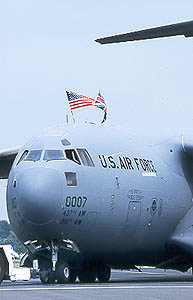 Finmeccanica
S.p.A. of Italy and GKN plc of the UK announced that subject to regulatory approval, they
have finalised their agreement to merge their helicopter businesses, the new company being
known as AgustaWestland. Finmeccanica and GKN will each own 50% of the joint venture post
completion, and with combined 1999 revenues of more than $2.1 billion and a civil and
defence order book of $8 billion, it will be a powerful force in the world Finmeccanica
S.p.A. of Italy and GKN plc of the UK announced that subject to regulatory approval, they
have finalised their agreement to merge their helicopter businesses, the new company being
known as AgustaWestland. Finmeccanica and GKN will each own 50% of the joint venture post
completion, and with combined 1999 revenues of more than $2.1 billion and a civil and
defence order book of $8 billion, it will be a powerful force in the world  helicopter industry. Agusta will
contribute its interests in the NH90 joint venture, NH Industries, whose other partners
are Eurocopter and Fokker as well as Agusta's share of the joint venture with Bell
Helicopter Textron of the US, which includes the new medium twin, the AB139 and the BA609
tilt rotor aircraft development. Subject to approval of the EU competition authorities
Finmeccanica and GKN expect that the new company will become fully operational in the
Autumn. Westland is, of course, heavily committed to two major UK military developments in
the next few years with the RAF/RN Merlin and AAC Apache
programmes, and it is expected that this merger will give the company the security it
needs to develop markets in other areas. helicopter industry. Agusta will
contribute its interests in the NH90 joint venture, NH Industries, whose other partners
are Eurocopter and Fokker as well as Agusta's share of the joint venture with Bell
Helicopter Textron of the US, which includes the new medium twin, the AB139 and the BA609
tilt rotor aircraft development. Subject to approval of the EU competition authorities
Finmeccanica and GKN expect that the new company will become fully operational in the
Autumn. Westland is, of course, heavily committed to two major UK military developments in
the next few years with the RAF/RN Merlin and AAC Apache
programmes, and it is expected that this merger will give the company the security it
needs to develop markets in other areas.
 And what of the flying displays? To be honest, Farnborough always serves up a
very enjoyable three hours of concentrated action. Always slickly organised, barely a gap
separates one landing from the next take-off, with the display slots themselves being
reasonably short and not too long-winded. The public days offer the best of the trade
days, mixed with some historic and modern-day RAF display routines, but it is the bespoke
displays by the manufacturer's fleets that is the character and attraction of Farnborough.
Although the display line is too far back for photography, it gives a chance to actually
watch the display without the distraction of getting that vital shot. And what of the flying displays? To be honest, Farnborough always serves up a
very enjoyable three hours of concentrated action. Always slickly organised, barely a gap
separates one landing from the next take-off, with the display slots themselves being
reasonably short and not too long-winded. The public days offer the best of the trade
days, mixed with some historic and modern-day RAF display routines, but it is the bespoke
displays by the manufacturer's fleets that is the character and attraction of Farnborough.
Although the display line is too far back for photography, it gives a chance to actually
watch the display without the distraction of getting that vital shot.
 Chris Worning and Keith Hartley rotated the display responsibility for
Eurofighter Typhoon during the week, and easily came away with the most impressive routine
of the week. Another notch up from the '98 display, when we first saw the potential, there
is apparently still more to come, thrust-vectoring or not. Keeping Chris Worning and Keith Hartley rotated the display responsibility for
Eurofighter Typhoon during the week, and easily came away with the most impressive routine
of the week. Another notch up from the '98 display, when we first saw the potential, there
is apparently still more to come, thrust-vectoring or not. Keeping  up hard was the Lockheed
Martin demonstration pilot in the latest F16C, but it was quite
obvious that the airframe was being worked very hard, in contrast with the effortless
moves of both Typhoon and the Super Hornet. The latter, looking almost indistinguishable
from the 'C or 'D in the air, moved in a more aggressive manner with the power to turn at
will. Even more impressive than the sole Russian representative, the Sukhoi
Su32, which seemed very tame after the thrust-vectoring antics of his stablemate two
years ago. But where was the Berkut? up hard was the Lockheed
Martin demonstration pilot in the latest F16C, but it was quite
obvious that the airframe was being worked very hard, in contrast with the effortless
moves of both Typhoon and the Super Hornet. The latter, looking almost indistinguishable
from the 'C or 'D in the air, moved in a more aggressive manner with the power to turn at
will. Even more impressive than the sole Russian representative, the Sukhoi
Su32, which seemed very tame after the thrust-vectoring antics of his stablemate two
years ago. But where was the Berkut?
Always impressive is the Airbus A340,
but didn't we see it all last time? Same with the C17, direct from Cottesmore, one of the
two aeroplanes eventually shared by the two airshows. The other was the C27J
Spartan, competing aggressively for the honour of best air transport display with the
C17 and C130J. Gripen tried hard as well,
as did an AMX, but in amongst Typhoon and the F/A18 would always
come away looking diminutive and second-best, maybe showing their earlier development and
hence rather elderly designs...
 A sparkling display was put on by three Embraer prop-liners, a quite remarkable
sight in itself as the three machines performed opposition passes and formation fly-bys.
I'll have some of what they were taking, please. Also amongst the displaying airliners was
a Fairchild 328Jet, and of a similar ilk was Saab's 340 Erieye, which performed a sedate routine, as did Westland's Apache
Longbow demonstrator, always too high and too far away. Apache is all about tree-top
surprising the enemy, just a shame that the display restrictions don't allow such a sight. A sparkling display was put on by three Embraer prop-liners, a quite remarkable
sight in itself as the three machines performed opposition passes and formation fly-bys.
I'll have some of what they were taking, please. Also amongst the displaying airliners was
a Fairchild 328Jet, and of a similar ilk was Saab's 340 Erieye, which performed a sedate routine, as did Westland's Apache
Longbow demonstrator, always too high and too far away. Apache is all about tree-top
surprising the enemy, just a shame that the display restrictions don't allow such a sight.
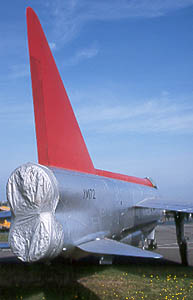 One
thing that always disappoints at Farnborough is the layout of the static display, with
little thought given to displaying the aircraft to their advantage. All the interesting
military pieces were crammed in the circular dispersal behind the crowdline, while the
Su32 sat all alone on the lazy runway with acres on unused space all around it. A few
years ago would have seen this space filled with exotic machinery from behind the Iron
Curtain, but this year the Russians stayed away, save the Su32 - also the runway would be
full of aircraft due to take their part in the flying display later on, but this year
there were but three. It was as if the SBAC had been expecting many more, as the One
thing that always disappoints at Farnborough is the layout of the static display, with
little thought given to displaying the aircraft to their advantage. All the interesting
military pieces were crammed in the circular dispersal behind the crowdline, while the
Su32 sat all alone on the lazy runway with acres on unused space all around it. A few
years ago would have seen this space filled with exotic machinery from behind the Iron
Curtain, but this year the Russians stayed away, save the Su32 - also the runway would be
full of aircraft due to take their part in the flying display later on, but this year
there were but three. It was as if the SBAC had been expecting many more, as the  helicopters were crammed in a small compound to the rear of the Beluga. A photographer's nightmare, such positioning does little to
show the aircraft off to their best advantage. When space is available, such as in the
Historic aircraft park, better use needs to be made of the entire show layout. Hidden were
the colours of the CAG-bird E2 Hawkeye and F/A18F in amongst the ludicrously tight
parking. helicopters were crammed in a small compound to the rear of the Beluga. A photographer's nightmare, such positioning does little to
show the aircraft off to their best advantage. When space is available, such as in the
Historic aircraft park, better use needs to be made of the entire show layout. Hidden were
the colours of the CAG-bird E2 Hawkeye and F/A18F in amongst the ludicrously tight
parking.
At £20 per head, it is difficult to say this airshow
offers value for money compared to RIAT, held just the week before. With all the big
business of the preceding days, maybe it should be up to the aircraft industry to offer
the public an airshow of its wares at a much reduced cost; make it ticket only if
necessary, to keep the numbers down to a manageable level. It seems Farnborough is at a
crossroads; does it concentrate on business, and become the biggest trade fair in the
world without aeroplanes, or does it look to its past and get back to being the 'world's
greatest airshow'? It could be done, given the will of the aerospace industry, but then
why would they want to?

|
